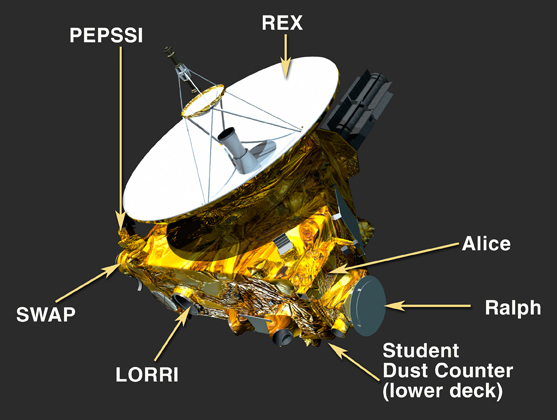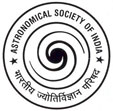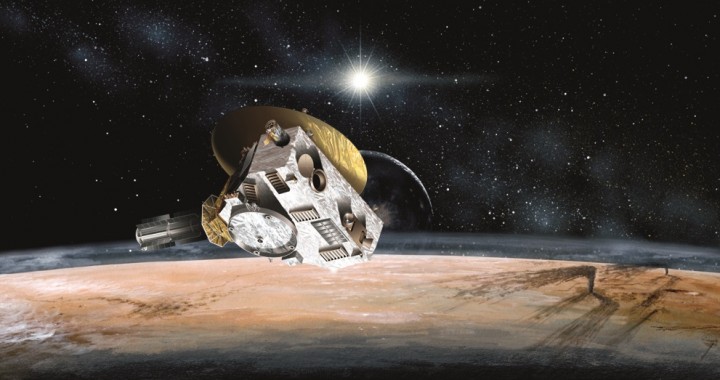On July 14th about 17:19 hrs IST (11:49 UTC) NASA’s New Horizon spacecraft, after a sojourn that lasted more than nine and half months, will make its close encounter with Pluto. So far even with best of the telescopes Pluto and its companion Charon were merely just blobs of light, hiding their surface feature, if any. The New Horizon, first ever mission to Pluto, is expected to remove the veil and reveal its full glory.
Surprisingly the spacecraft is small, just a size of a piano, weighing under 480 kg and just 2.5 meter across. Yet the suite of seven powerful scientific instruments on-board including the first ever ‘student’ built and ‘flown’ scientific payload, Student Dust Counter (SDC) along with three optical instruments, two plasma instruments, a dust sensor and a radio science receiver, are potent.
After making a five billion kilometre long journey over nine and half years, the spacecraft has to reach a point near Pluto with an accuracy of about 100-150 km and that too within 100 seconds. That is the kind of precision the spacecraft has to navigate to, if it has to keep its date with Pluto on July 14, 2015.
On July 14, 2015, New Horizon will make a flyby at just 12500 km from Pluto. It will also go as close as 28,800 km near Charon, largest of the five moons of Pluto. These close-up shots are expected to reveal surface features and provide geological, atmospheric data.
Pluto is located in the Kuiper belt, a disc-shaped region of icy objects beyond the orbit of Neptune — billions of kilometers from our sun, a region named after Dutch-American astronomer Gerard Kuiper. This region is also home to a number of comets and icy objects named KBOs (Kuiper belt objects) which scientists believe are frozen mini-planets and building blocks left over from the solar system’s formation 4.6 billion years ago. Hence astronomers hope, by studying them, one could make sense of the how the solar system evolved. It is with this mission of studying the Kuiper belt objects that NASA launched the New Horizon mission on January 19, 2006.
Pluto

the New Horizons spacecraft on 12 July 2015
Inner planets such as Mercury, Venus, Earth and Mars are terrestrial planets rich in metals such as iron. The Gaseous planets such as Jupiter and Saturn are less dense and are essentially filled with lighter elements such as Hydrogen and Helium. Uranus and Neptune are frozen gaseous planets mostly made up of hydrogen and helium, but rich in frozen methane.
Pluto is a icy planet frozen at about minus 233 degrees, with large percentage of ammonia, water ices, and other compounds such as methane. This is the same composition that comets have. Pluto has a very thin atmosphere, just one part in one lakh of Earth’s atmosphere. Pluto’s atmosphere is rich in nitrogen just like Earth, but Pluto’s atmosphere is rich in methane and carbon-dioxide and is devoid of oxygen. Its largest moon is Charon which is locked with Pluto gravitationally. Four additional moons were discovered only recently.
At farthest reaches
Pluto is about 750 crore kilometre away from Sun and at that distance light will take about 7 hours to reach it. From Pluto, Sun would be 900 times fainter than it is on Earth, although that amount of brightness is still 300 times brighter than the full moon, illumination adequate to read a book. The spacecraft is powered by plutonium since the sunlight will be too weak at that distance to generate necessary power.
To be or not be a planet?
Since the discovery of Neptune in 1846, astronomers have predicted that there would be a ninth planet in the Solar System, which they called Planet X. After a massive hunt with ingenious contraptions, Clyde W. Tombaugh, then just 22 years old, discovered Pluto using the Lowell Observatory in Flagstaff, Arizona. At the time of discovery and subsequently, this tiny celestial object has remained an odd curiosity.
Alas, although it was still considered a planet when the New Horizon was launched, within a few months, astronomers from across the world, who gathered for the congress of the International Astronomical Union in 2006, removed Pluto from the list of planets and re-classified it as a ‘dwarf planet’.
Over the last few decades, powerful new ground and space-based observatories have unraveled hitherto unknown parts of our solar system. Instead of being the only planet in its region like the inner Solar System, Pluto and its moons are now known to be just one among the large collection of objects called the Kuiper Belt objects (KBOs), found in a region beyond Neptune and extending out to 55 astronomical units (55 times the distance of the Earth to the Sun).
One estimate places the number of KBOs to be 70,000 icy objects, all with the same composition of Pluto and many measuring more than 100 km across. The discovery of a bigger KBO called Eris – 2,600 km across and about 25% more massive than Pluto – nailed the debate.
Although bats fly, it is a mammal; Penguins cannot fly, but are expert swimmers, yet they are birds. The re-classification of Pluto as dwarf planet is similar to this. A Planet has to go around the Sun and have enough mass (gravity) to form a spherical shape. Pluto meets both these criteria. However according to astronomers, for an object to be classified as a Planet it had to satisfy another crucial criteria – that it needs to have “cleared its neighbourhood”. This is where Pluto fails.
What does “cleared its neighbourhood” mean? When a proto-planet forms and evolves, it becomes the dominant gravitational body in its orbit, sweeps up the rest of the materials around and grows in size. In the end either it consumes almost all the objects near it or slings them away with its gravitational interactions. However Pluto is only 0.07 times the total mass of the other objects in its orbit. The Earth, in comparison, has 1.7 million times the mass of other objects in its orbit.
Any object that does not meet the astronomers’ third criterion is classified as a dwarf planet. And so, Pluto is a dwarf planet.
All eyes and ears

The instruments on New Horizons were all designed to work together to give us a comprehensive picture of the Pluto system. Seven instruments, Venetia Burney Student Dust Counter (SDC), Pluto Energetic Particle Spectrometer Science Investigation (PEPSSI), Solar Wind Around Pluto (SWAP), Long Range Reconnaissance Imager (LORRI), Radio Science Experiment (REX), Ralph and Alice. Together they will help scientists study Pluto’s geology, surface composition, temperature and atmosphere—as well as its five moons.
All the instruments aboard the spacecraft were in sleep mode until now and were tested for their performance only last April. When the spacecraft approached Pluto at 11.3 crore km the first photos were clicked with the telescopic Long-Range Reconnaissance Imager-LORRI. The spacecraft has already sent stunning images of Pluto and its moon Charon. These images reveal a potential snow cap, a mysterious elongated dark feature at the equator, which has been dubbed the “whale”, and a large heart-shaped bright region measuring about 2000 km across.
The high tech spacecraft has also pictured Pluto’s largest moon, Charon, and given scientists their clearest ever look at the giant ball of ice. The new images reveal a barren landscape of vast craters and chasms – the largest of which is believed to be miles deeper than Earth’s own Grand Canyon.The most prominent crater on Charon is about 100 km across and lies near the South Pole of the moon. There are the incipient evidence of geologic activity such as faulting and surface disruption on Charon, which was thought to be a nearly featureless ball of ice until now.
Most intensive remote-sensing and imaging activities will take place during the half-hour flyby window when the spacecraft whizzes past Pluto. When the spacecraft is closest to the planet it can even resolve surface feature just 60 km across and provide images with more clarity and definition. These images will have about 10,000 times more detail than the pictures we have so far. When the spacecraft is close-by, PEPSSI will study material such as nitrogen and carbon monoxide that escapes from Pluto’s atmosphere and is then ionized by ultraviolet light from the Sun.
Scientists suspect Pluto, Charon and their four small moons, all discovered in Hubble images after New Horizons was launched, formed after an ancient collision of two icy bodies. That theory will be tested with the new evidence of the tumbling, wobbly moons, and observations by New Horizons.
Bulletproof vest
New Horizon hurling at a breakneck speed of about 54000 km/h would break into pieces if it collided with space rocks or debris. Further collision with micro meteoroids could puncture the instruments. To protect the instruments, the spacecraft is adorned with a bulletproof vest made out of 18 layers of Dacron mesh cloth sandwiched between aluminized Mylar and Kapton film, which also acts as a thermal blanket. Space is a very very cold place. For electronic equipment to work a minimum heat is required and New Horizons’ unique “thermos bottle” design retains heat and keeps the spacecraft operating at room temperature without the need for power hungry large heaters.
Why just a brief rendezvous?

One may wonder why after this arduous ten month journey the spacecraft spends just 30 minutes close by Pluto. Why cannot it orbit once or twice around the planet, as India’s MOM does around Mars? It will take 700 years for even the fastest jet to reach Pluto at 750 crore km. Flying at a speed of 49,570 kilometers per hour, it is the fastest spacecraft ever launched. At this speed one would be able to traverse the distance between Chennai and Trichy is just one minute. If you have to make this racing spacecraft to orbit around Pluto then one has to reduce its speed by about 90%, for that one would require 1000 times more fuel in the spacecraft.
Mission accomplished?
The mission is not complete after its date with Pluto on July 14th 2015. It is only the first step for the spacecraft in its quest. As it recedes away from Pluto, just like the famous Raja Ravi Verma’s Shakunthala painting, it will turn and take a look at the night side of Pluto. In the silhouette of the Sun’s rays it will examine the thin atmosphere as well as search for rings around the planet. To conserve the power for the immediate task the pictures and data would be stored on on-board memory and relayed to Earth during the course of next 16 months.
Depending upon the fuel that remain after this crucial operation, NASA would determine a suitable KBO candidate as its next destination. If all goes well, it may then head into the Kuiper Belt for a possible flyby of a second object in 2019.
Author: T V Venkateswaran (Vigyan Prasar)
Images:
© 2015 The Johns Hopkins University Applied Physics Laboratory LLC.
Extras:
Article in Tamil: Link
Find the Latest Official News here : http://pluto.jhuapl.edu/News-Center/index.php

